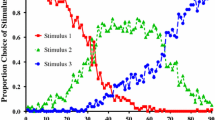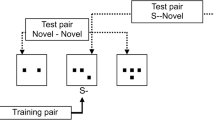Abstract
We trained eight pigeons (Columba livia) on a stagewise go/no-go visual discrimination task. A total of 16 visual stimuli were created from all possible combinations of four binary dimensions: brightness (dark/bright), size (large/small), line orientation (vertical/horizontal), and shape (circle/square). In the first stage, we presented S + and four S– stimuli: sharing one (brightness), two (brightness and orientation), three (brightness, orientation, and size), or no dimensional values with S + . In the second stage, all 16 stimuli were presented. In the first stage, stimulus discrimination was controlled by the number of dimensional disparities between non-rewarded stimuli and a rewarded one rather than by stimulus dimensional salience, whereas at the beginning of the second stage, pigeon behaviour was controlled mainly by dimensional reinforcement expectancy learned in the first stage. At the beginning of the second stage, pigeons correctly rejected 6–8 of 11 new added S- stimuli. A significant inverse correlation between the number of S– stimuli sharing dimension values with S + in the first stage and the dimensional discrimination ratios at the beginning of the second stage was found.




Similar content being viewed by others
References
Campos HC, Debert P, da Silva BR, McIlvane WJ (2011) Relational discrimination by pigeons in a go/no-go procedure with compound stimuli: a methodological note. J Exp Anal Behav 96(3):417–426
Castro L, Wasserman EA (2013) Information-seeking behavior: Exploring metacognitive control in pigeons. Anim Cogn 16(2):241–254. https://doi.org/10.1007/s10071-012-0569-8
Chatlosh DL, Wasserman EA (1993) Multidimensional stimulus control in pigeons: Selective attention and other issues. In: Zentall TR (ed) Comparative cognition and neuroscience. Animal cognition: A tribute to Donald A. Riley. Lawrence Erlbaum Associates, Incorp, pp 271–292
Fields L, Verhave T, Fath S (1984) Stimulus equivalence and transitive associations: a methodological analysis. J Exp Anal Behav 42(1):143–157. https://doi.org/10.1901/jeab.1984.42-143
Garcia KS, Mauk MD, Weidemann G, Kehoe EJ (2003) Covariation of alternative measures of responding in rabbit (Oryctolagus cuniculus) eyeblink conditioning during acquisition training and tone generalization. Behav Neurosci 117:292–303
George DN, Pearce JM (1999) Acquired distinctiveness is controlled by stimulus relevance not correlation with reward. J Exp Psychol Anim Behav Process 25(3):363–373. https://doi.org/10.1037/0097-7403.25.3.363
Gottselig JM, Wasserman EA, Young ME (2001) Attentional tradeoffs in pigeons learning to discriminate newly-relevant visual stimulus dimensions. Learning and Motivation 32(2): 240–253. https://doi.org/10.1006/lmot.2000.1081.
Kehoe EJ (2008) Discrimination and generalization. In: Menzel R (ed.), Learning theory and behavior. vol. 1 of learning and memory: A comprehensive reference, Vol. 1. Elsevier, Oxford, pp 123–150 https://doi.org/10.1016/B978-012370509-9.00059-0
Kruschke JK, Johansen MK (1999) A model of probabilistic category learning. Journal of Experimental Psychology. Learning, Memory, and Cognition 25(5): 1083–1119. https://doi.org/10.1037//0278-7393.25.5.1083
Lionello-DeNolf KM, Urcuioli PJ (2002) Stimulus control topographies and tests of symmetry in pigeons. J Exp Anal Behav 78(3):467–495. https://doi.org/10.1901/jeab.2002.78-467
Mackintosh NJ, Little L (1969) Intradimensional and extradimensional shill learning in pigeons. Psychonomic Sci 14(1):5–6. https://doi.org/10.3758/BF03336395
McIlvane WJ, Dube WV (2003) Stimulus control topography coherence theory: Foundations and extensions. Behav Anal 26(2):195–213. https://doi.org/10.1007/BF03392076
McKinley SC, Nosofsky RM (1996) Selective attention and the formation of linear decision boundaries. J Exp Psychol Hum Perception Performance 22(2): 294–317. https://doi.org/10.1037//0096-1523.22.2.294
Pashler HE (1998) The psychology of attention. MIT Press, Cambridge
Pilgrim C, Galizio M (1996) Stimulus equivalence: a class of correlations or a correlation of classes? In: Zentall TR, Smeets PM (eds) Stimulus class formation in humans and animals. Elsevier, Amsterdam, pp 173–195
Ray BA, Sidman M (1970) Reinforcement schedules and stimulus control. In: Schoenfeld WN (ed) The theory of reinforcement schedules. Appleton-Century-Crofts, New York, pp 187–214
Reynolds GS (1961) Attention in the pigeon. J Exp Anal Behav 4:203–208. https://doi.org/10.1901/jeab.1961.4-203
Riley DA, Roitblat HL (1978) Selective attention and related cognitive processes in pigeons. In: Hulse SH, Fowler H, Honig WK (eds) Cognitive processes in animal behavior. Erlbaum, Hillsdale, NJ, pp 249–276
Sidman M, Rauzin R, Lazar R, Cunningham S, Tailby W, Carrigan P (1982) A search for symmetry in the conditional discriminations of rhesus monkeys, baboons, and children. J Exp Anal Behav 37(1):23–44. https://doi.org/10.1901/jeab.1982.37-23
Soto FA, Wasserman EA (2010) Integrality/separability of stimulus dimensions and multidimensional generalization in pigeons. J Exp Psychol Animal Behavior Processes 36(2): 194–205. https://doi.org/10.1037/a0016560
Soto FA, Wasserman EA (2011) Asymmetrical interactions in the perception of face identity and emotional expression are not unique to the primate visual system. J Vis 11(3): article 24 https://doi.org/10.1167/11.3.24
Sutherland NS, Mackintosh NJ (1971) Mechanisms of animal discrimination learning. Academic Press, New York
Teng Y, Vyazovska OV, Wasserman EA (2015) Selective attention and pigeons’ multiple necessary cues discrimination learning. Behav Proc 112:61–71. https://doi.org/10.1016/j.beproc.2014.08.004
Thomas DR (1970) Stimulus selection, attention, and related matters. In: Reynierse JH (ed) Current issues in animal learning. University of Nebraska Press, Lincoln, pp 311–356
Tomie A, Davitt GA, Thomas DR (1975) Effects of stimulus similarity in discrimination training upon wavelength generalization in pigeons. J Comp Physiol Psychol 88(2): 945–954. https://doi.org/10.1037/h0076434. PMID: 1150957
Trabasso T, Staudenmayer H (1968) Random reinforcement in concept identification. J Exp Psychol 77(3, Pt.1): 447–452. https://doi.org/10.1037/h0025954
Trabasso T, Bower GH, Gelman R (1968) Attention in learning: theory and research. Wiley, New York
Underwood BJ (1963) Stimulus selection in verbal learning. In: Corer CN, Musgrave BS (eds.), Verbal behavior and learning. McGraw-Hill, New York, pp 33–75. https://doi.org/10.1037/11178-003
Vyazovska OV, Teng Y, Wasserman EA (2014) Attentional tradeoffs in the pigeon. J Exp Anal Behav 101(3):337–354. https://doi.org/10.1002/jeab.82
Vyazovska OV, Navarro VM, Wasserman EA (2016) Stagewise multidimensional visual discrimination by pigeons. J Exp Anal Behav 106(1):58–74. https://doi.org/10.1002/jeab.217
Vyazovska OV, Navarro VM, Wasserman EA (2018) Pigeons deploy selective attention to efficiently learn a stagewise multidimensional visual discrimination task. J Exp Psychol Ani Learn Cognition 44(2): 162–167. https://doi.org/10.1037/xan0000168
Acknowledgements
I would like to thank for their technical support Pryhod’ko O.P., Associate Professor in the Department of Applied Mathematics, School Mathematics and Computer Sciences, V.N. Karazin Kharkiv National University; and Podcherniaiev S.D., Engineer in the Department of Physical and Biomedical Electronics and Complex Information Technologies, School of Radiophysics, Biomedical Electronics and Computer Systems, V.N. Karazin Kharkiv National University.
Funding
This study was not funded by any grants.
Author information
Authors and Affiliations
Corresponding author
Ethics declarations
Conflict of interest
The author declares that she has no conflict of interest.
Ethical approval
All applicable international, national, and/or institutional guidelines for the care and use of animals were followed. This article does not contain any studies with human participants performed by the author.
Additional information
Publisher's Note
Springer Nature remains neutral with regard to jurisdictional claims in published maps and institutional affiliations.
Supplementary Information
Below is the link to the electronic supplementary material.
Rights and permissions
About this article
Cite this article
Vyazovska, O.V. The effect of dimensional reinforcement prediction on discrimination of compound visual stimuli by pigeons. Anim Cogn 24, 1329–1338 (2021). https://doi.org/10.1007/s10071-021-01526-z
Received:
Revised:
Accepted:
Published:
Issue Date:
DOI: https://doi.org/10.1007/s10071-021-01526-z




